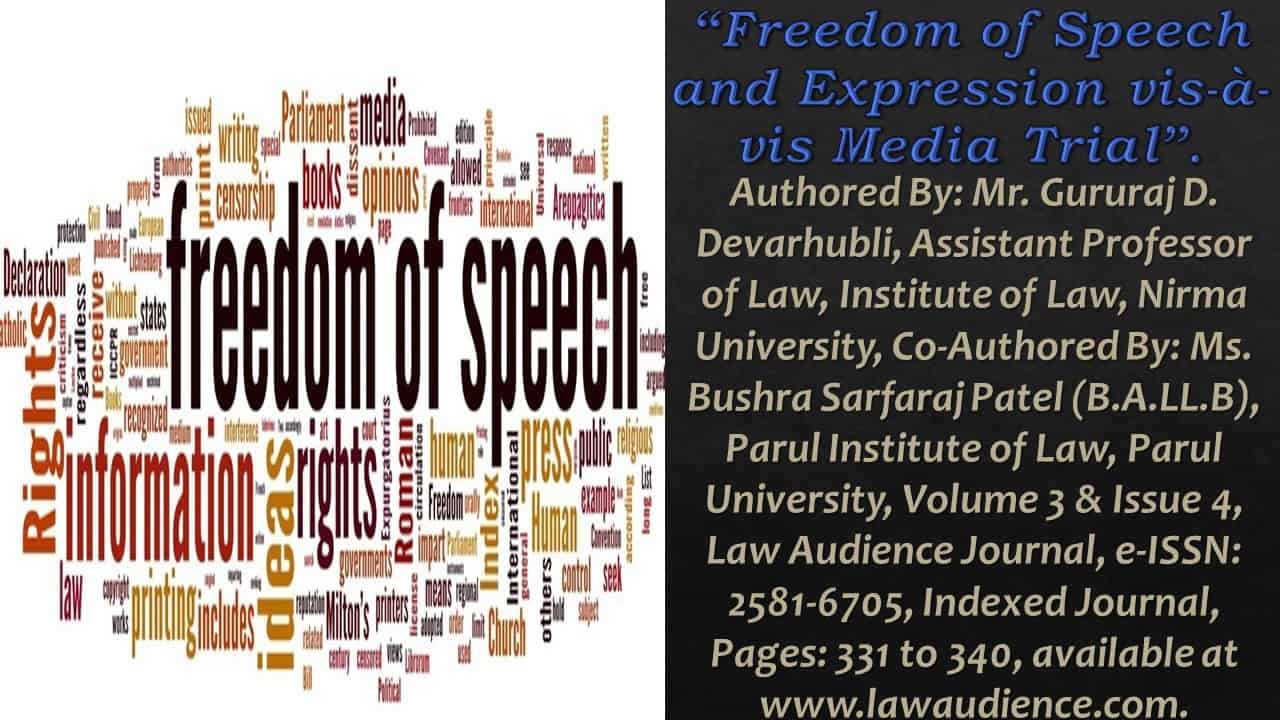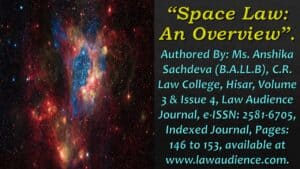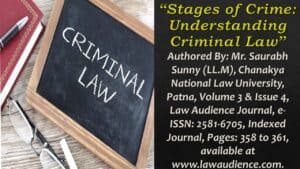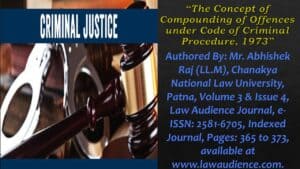Click here to download the full paper (PDF)
Authored By: Mr. Gururaj D. Devarhubli, Assistant Professor of Law, Institute of Law, Nirma University,
Co-Authored By: Ms. Bushra Sarfaraj Patel (B.A.LL.B), Parul Institute of Law, Parul University,
Click here for Copyright Policy.
I. INTRODUCTION:
It has been a normalized culture where media portrays itself as a trial court for the public and tends to infringe on the ongoing proceeding of the court in India. They more or less have a biased opinion about the accused or victim and project them so conveniently to the general public that the principle of “presumption of innocence until proven guilty” is completely discarded from their minds. It’s no doubt media has a shield in the name of freedom of the press which might not be expressly mentioned in the Constitution of India but various judicial pronouncements have recognized the freedom of the press included in freedom of expression. In the case of Romesh Thappar vs. the State of Madras[1], it was held that the foundation of all democratic organizations is laid by the freedom of speech and expression. But when the media go beyond the coverage of a particular ongoing proceeding is not only prejudice the minds of the public but it stands a possibility to prejudice the mind of the judiciary as well. Free speech in true sense means liberty to voice & express what one wants to convey. It is an innate right and its acquisition through the natural form. It is understood by the makers of the Constitution that the opportunity and platform of discuss an issue or express an idea through various freely is important its citizen and thus shall be considered as a part of human rights in India.
Even in the Bill of Rights, as per the Article 9 the “freedom of speech” was subject of strict restriction where every citizen had the liberty to express their opinion in whichever form suited to them but having said that they shall also take full responsibility of the abuse of such right. On a similar note, the India Constitution states that freedom of speech and expression is not unbridled and shall be subjected to reasonable restrictions made by the State concerned on grounds such as state security, contempt of courts, etc. Such reasonable restriction is important to protect the democracy of the nation from the abuse of rights. In the leading case, it has been held by the Supreme court that freedom of the press involves the right to know news and information regarding administration of the government. Though it is pertinent to note that such rights are subjected to reasonable restrictions and thus to perceive them as absolute rights in the interest of the general public at large. Media on the other stands a fourth pillar of the Indian Constitution. It owes the duty of information broadcasting, awareness, and education. It acts as a vigilant of Government activities and functions by providing simple access to the masses through broadcasting the government’s affairs as well as any important events taking place around the world through means television, radio, applications, internet, newspapers, etc. The problem begins when the media excessively abuses its power and broadcasts national issues in a biased manner. Distorting the material facts, favoured opinion, and exaggeration of issues in order to gain the attention of the masses in order to be in demand tends to diverge them from the actual object of their institution.
There are various negative consequences of such acts of media India is a country that is majorly comprised of youths who tend to be of the fragile mind and boiled blood. They can be easily influenced which in chain reaction result for a cause of rebellion attitude as that behaviour has been trending among their age group. When media cross their limit of power by misleading facts and biased opinion especially regarding any ongoing cases in court it causes the damages to the reputation of a person party in the case beyond repair even if they are found not guilty. Apart from the reputation damage, it may also cause obstruction to justice as it may hinder the “right to a fair trial”. Therefore, it is highly important for the media to understand that when they have the power to reach the masses, they need to undertake the responsibility of fair and neutral manner of imparting or broadcasting information to the public at large.
II. CONSEQUENCES OF MEDIA TRIAL:
“Every institution is liable to be abused, and every liberty, if left unbridled, has the tendency to become a license which would lead to disorder and anarchy. Freedom of press is highly important for smooth functioning of a democratic nation but in the words of Theodore Levitt “anything in excess is poison”. Therefore, media should work in its jurisdiction in just and fair manner in the interest of society. In India, media trial stands in process of fair trail and interferes with the proceedings and completely disregarding the principle of presumption of innocence until proven guilty. Media has presented themselves as a “Populace Court” in pursuance of which they present a biased opinion about any ongoing proceeding which in turn creates an undue influence of media trial in the administration of justice.
The media in order to gain public attention twist the material facts and sensationalized the case. They often declare their own judgement regarding an ongoing case even before court gives its own verdict and do not have any accountability for the same. In a landmark case Supreme Court observed that the media creates its own perception about the parties in a case cause grievous damage to their reputation regardless of judgment of court of record. It’s been often observed that media tend to provoke the public atmosphere especially in cases which have sensitive issue.
This not only leads to various mob lynch events but also hinders the process of fair trail where the accused is already declared guilty regardless of the verdict of court due to which the accused might have to live the rest of their life under intense public scrutiny. In another case it was observed that No doubt it would be mischievous for a newspaper to systematically conduct an independent investigation into a crime for which a man has been arrested and to publish the results of that investigation.
This is because trial by newspapers, when a trial by one of the regular tribunals of the country is going on, must be prevented. The basis for this view is that such action on the part of a newspaper tends to interfere with the course of justice whether the investigation tends to prejudice the accused or the prosecution. There is no comparison between a trial by a newspaper and what has happened in this case. It is therefore responsibility of the court to protect the dignity of the individuals in the cases from the attack of media trail. The court devised various strategies in order to deal with issues of media trail.
III. COMMITTEE REPORTS ON PUBLICATIONS RESULTING IN CONTEMPT OF COURT: BASIC CONCEPT OF LAW RELATED TO CONTEMPT OF COURT:
The constitution of India is based on the principle of the “Rule of law” principle. The Democratic society has assigned the judiciary the role to make citizens abide by rules and follow the court. The judiciary is vested with powers to punish for its contempt. The Contempt of Courts Act, 1971 defines Criminal and civil contempt which regulates the powers and procedure to punish for contempt of courts.” Article 19(1)(a) of the constitution of India which Right to Freedom of Speech and Expression can be restricted by the Article 129 and Article 215 of the constitution respectively which empowers The Supreme Court and High Court to punish people for their contempt.
III.I SANYAL COMMITTEE REPORT[2]:
The committee was set up in 1961 under the Chairmanship of Late H. N. Sanyal who was the additional Solicitor General at that time. The committee gave significance to Freedom of Speech under the Constitution and the necessity of protecting the dignity, status of the Courts and the interests of “administration of Justice”. The Committee intended in protecting the interests of the suspects where “Criminal proceedings” were pending or imminent. If any person made such publication which could prove that there were no as such reasonable grounds to believe that the case was imminent, then it would not be liable for contempt of Court.
III.II JOINT COMMITTEE OF PARLIAMENT:
The Joint Committee of Parliament (Bhargava Committee) reviewed the Sanyal Bill as it suggested that the interpretation of the word “Imminent” was vague and it unreasonably restricts the “freedom of speech” As a result, the committee omitted all the references to “imminent” proceedings or to “arrest” from being the commencement of a pending “Criminal proceeding” under the Contempt of Courts Act, 1971.
III.III CONTEMPT OF COURTS ACT, 1971:
This Act imposes “reasonable restrictions” on right to freedom of speech and expression guaranteed under Constitution of India. Under the Act, if a publication interferes or in any way tends to interfere with the administration of justice, then it might amount to criminal contempt as per Sections 2 and 3 of the Act of 1971. According to Section 3 of the Act, if a person publishes any matter without any reasonable ground to believe that the proceeding was pending and if the matter published is interfering with or obstructing the “course of justice” or tends to obstruct it, the person would not be liable for contempt of Court. The Act immunises the media from prejudicial publications before a trial has been started. In a way, it gives media the freedom to publish and broadcast on such matters which may later turn into out to be prejudicial to the trial that has not yet started.
III.IV 200th LAW COMMISSION REPORT[3]:
The seventeenth Law Commission report through its 200th report on “Trial by Media: Free Speech vs. Fair Trial Under Criminal Procedure (Amendments to the Contempt of Courts Act, 1971)” has made several recommendations including the subject relating to media trial Suo motu, after considering the large-scale coverage by the “Print and electronic media” of the crime and information relating to accused and suspects. In this Law Commission Report, it has been pointed out that the Supreme Court and the House of Lords have accepted that the judges are affected subconsciously by the prejudicial publications relating to an accused or suspect. In A.K. Gopalan vs. Noordeen, the Supreme Court observed that a “prejudicial publication” about the accused or suspect which is made after a person is arrested then it could be treated as arrested. A K Gopalan was acquitted by the Court, who actually made a statement after the filing of a FIR but before the arrest was made, While the editor of the Newspaper and others were Convicted for contempt because of prejudicial publications were made after the arrest. The Law Commission Report asserted that prejudicial publications would be criminal contempt if a person is “arrested” or the “criminal proceedings are imminent”. The law Commission report has further made a recommendation to use the word “active” rather than “pending” criminal proceeding in section 3 of the Act of 1971. The report ascertained various grounds of publication which would lead to criminal contempt. It also recommended that it is required to train the journalist in some specific facets of law relating to “freedom of speech and expression” and restrictions permitted by the Article 19(2) of the Constitution of India. The Law commission therefore suggested every possible change that could help in removing the interference with the due “administration of criminal justice.”
IV. ANALYSIS OF THE IMPACT OF MEDIA TRIAL IN THE LIGHT OF JUDICIAL DEVELOPMENT BY RELEVANT LANDMARK CASES:
IV.I AARUSHI TALWAR, NOIDA DOUBLE MURDER CASE, 2008[4]:
The case where a fourteen-year-old girl Aarushi Talwar and a forty-five-year-old Hemraj Baanjade was murdered and the case was a big bombard on media trial arena. Aarushi was the only child of her parents and Hemraj was the domestic worker living in Noida, Uttar Pradesh. On 16 May 2008, dead body of Aarushi was discovered and at the same time servant Hemraj was missing because of which he was considered to be the main accused. However, next day, dead body of Hemraj was discovered on the terrace itself. The police were severely criticized because of negligence and failure to secure the crime scene. Later on, the police found Rajesh Talwar, Aarushi’s father as the prime suspect after finding Hemraj and his daughter in “objectionable” position or because Hemraj blackmailed him for his alleged extra marital affair.
The case was transferred to the CBI where the compounder of Rajesh’s clinic was found to be the suspect but later on in 2009, the case was again transferred to a new team of CBI because of critical gaps in evidence. In the year 2013, the parents were declared to be guilty and were sentenced to life imprisonment. In 2017, they were acquitted by the Allahabad High Court as the evidence against the Talwars were not satisfactory. There was a huge media coverage in print and electronic media to deliver justice to the girl. At the same time, many media houses also raised questions on the character of the girl which was criticized later.
A PIL was filed by Dr. Surat Singh, an advocate where he mentioned his disagreement and disheartening of the news and the press in the case. The court said that the media, both print and electronic, while publishing any news relating to the case in question should be cautious because it may prejudice the defence of the accused or may damage the reputation of every person associated with the. “The Supreme Court ordered restraint on “published material which may case. interfere with the investigation process in respect of all cases.
IV.II SUNANDA PUSHKAR DEATH CASE[5]:
The case of Sunanda Pushkar was a high-profile matter as she was the wife of renowned politician Shashi Tharoor who was found dead in the hotel at Delhi on January 17, 2014. The body was discovered by the police after getting information from Shashi Tharoor and sent for postpartum. Initially the reports were normal but later on it was found that the reasons of her death were not natural and had injury marks on her body on the autopsy report given by AIIMS. Finally, an investigation by sub-divisional magistrate came to conclusion that the death was due to poisoning. But on the very day, media houses reached the crime scene and raised questions about the mysterious death which dominated all over the electronic as well as print media.
In fact, the media trial soon began and started declaring Shashi Tharoor as the murderer. Some of the media houses even interviewed a far-off cousin of Shashi Tharoor who even claimed that it was a clear case of murder. This trial by the media houses created a huge impact on the minds of the whole nation setting up prejudices at peak. It created a necessity to run a board to judge the basic morals of every media house while covering any proposition of the story. In 2017, Shashi Tharoor filed a defamation suit against a well-known media house in Delhi High Court. The Court dignified the “right to silence” of Shashi Tharoor to be maintained by the journalist and his channel during the pendency of the investigation in Sunanda Pushkar’s death case. The Court also stated that the Journalist and his channel are free to state facts in relation to the investigation but cannot announce Shashi Tharoor to be the murderer. The suit also raised the concern for a balance between free speech and media trial. The media is definitely not entitled to defame a person who is still under the administration of judiciary and the judgement of a Court should be final but the media house is competent to conduct a trial without prejudices per se.
IV.III JESSICA LAL MURDER CASE[6]:
The murder mystery of a model named Jessica Lal was a hit on medial houses in around the year of 1999. The model was a bartender at a restaurant named as “Tamarind Court” situated in Delhi where she was shot by a gun which resulted her death. There were hundreds of people in that restaurant on that night where Manu Sharma, son of Vinod Sharma who was a minister then shot her because the deceased refused for a drink as the bar was closed by then. Manu even offered for extra money to get the drink but Jessica abided by rules and refused for the same. The police couldn’t arrest Manu Sharma as his friends helped him to escape and even destroyer the evidence such as the revolver. After many failed attempts of getting justice to Jessica, finally on March 2006, Manu Sharma was declared as guilty by the High Court. A magazine named “Tehelka” carried out a special sting operation which revealed various evidences such as Manu Sharma’s father bribing the witnesses to keep them away from the case. These operations were even broadcasted on various different channels. Manu Sharma’s defence lawyer Ram Jethmalani argued in the Supreme Court that his client was maligned and targeted by the media before and during the proceedings, which proclaimed him guilty even after the trial Court acquitted Manu Sharma.” The Court further admitted that the accused was affected by the “trial by media” although believed that the media trial cannot influence the decision of High court. The Court also held that the role of the media should be restricted by the freedom which may lead to serious prejudice and risk of influencing the signatories. It also laid down that “trial by media” should not be hindrance to fair investigation or more importantly any prejudice which causes obstruction to the right of defense of the accused. If either of this leads to obstruction in the fair investigation and trial it will amount travesty of justice.’
IV.IV TARUN TEJPAL SEXUAL ASSAULT CASE[7]:
This case is the accusation of rape against the chief editor of Tehelka”, Mr. Tarun Tejpal on his colleague. The accusation was brought by a women journalist who worked with Tarun Tejpal and accused him of sexually assaulting her in an elevator in a five-star hotel in Goa during a conference named “Thinkfest” which was organized by “Tehelka”. During the trial, a channel improperly presented views which could discredit the victim while the cross examination was not taken place. There were several videos and reports all over internet on the website of the alleged channel but after a lot of debate and controversies, the matter available on the website was deleted because of certain legal consequences.
IV.V M.P. LOHIA VS. STATE OF WEST BENGAL[8]:
In this case, a woman had committed suicide in her parents’ house in Calcutta and the deceased’s husband and relatives were accused of dowry death but got a bail because he submitted medical reports of him being schizophrenic. The matter got very famous on media specially as ‘Saga’ titled “Doomed by Dowry written by one Kakoli Poddar based on her interview of the family of the deceased. While disposing the bail petition, the Court said that, “We deprecate this practice and caution the publisher, editor and the journalist who was responsible for the said article against indulging in such trial by media when the issue is subjudiced.”
V. ROLE OF JUDICIARY IN MEDIA TRIAL:
By several case laws and studies, it could be understood that the judiciary is likely to get sub-judices and could be influenced subconsciously but the depth of knowledge and proximity of judges cannot be questioned. There should be a certain ethical duty of the media houses to follow the norms and try not to be prejudiced. In Reliance Petrochemicals vs. Proprietor of Indian Express, and in the light of P.C. Sen Case20, it can be stated that the Hon’ble Supreme Court acknowledged that judges are likely to be influenced subconsciously by media attention. Hence, Judiciary plays a very important role in setting up certain limitation upon freedom of Media while broadcasting or publishing any matter in respect to certain prejudice.
VI. SIGNIFICANT TAKEAWAY:
Freedom of Speech and expression is a fundamental right which has been a very important factor which makes the fourth pillar of our Democracy stand tall and strong. Yet there are challenges and certain restrictions due to which it cannot be allowed to transgress its advantage or position subject to any prejudices as a part of unfettered power of public importance. Indian Constitution has a very broad scope to impose restrictions and authorise the media to be in control under Article 19(2) of the Constitution. There has been a huge debate on Media houses making an arrangement with corporate houses for not broadcasting anything against them by wholesome immoral consideration but the present act including Contempt of Courts Act, 1971 has validated the regulation of balancing the fundamental right and reasonable grounds of restrictions, not abiding which could create serious legal consequences and punishments. Media acts like a watchdog who takes up the voice of the public to the attention of appropriate authorities. Although it plays a negative role most of the times by various controversies and prejudices but it has shown to be an eminent platform to bring justice to many by sting operations and collecting evidence by certain advantages of being in the profession. The Indian press council plays a crucial role by regulating strict rules and regulations for the media while Court could also impose damages to media houses for abusing the contempt of Courts or creating a hindrance while administration of justice.
Cite this article as:
Mr. Gururaj D. Devarhubli & Ms. Bushra Sarfaraj Patel, “Freedom of Speech and Expression vis-à-vis Media Trial”, Vol.3 & Issue 4, Law Audience Journal (e-ISSN: 2581-6705), Pages 331 to 340 (26th April 2022), available at https://www.lawaudience.com/freedom-of-speech-and-expression-vis-a-vis-media-trial/.
Footnotes & References:
[1] 1950 AIR 124, 1950 SCR 594.
[2] Report of the Committee on Contempt of Courts, 1963, available at https://indianculture.gov.in/report-committee-contempt-courts-1963.
[3] Law Commission Report No. 200- Trial by Media, Free Speech vs. Fair Trial Under Criminal Procedure (Amendments to the Contempt of Court Act, 1971), 2006, available at https://lawcommissionofindia.nic.in/reports/rep200.pdf.
[4] 2008 Noida double murder case, available at https://en.wikipedia.org/wiki/2008_Noida_double_murder_case.
[5] Sunanda Pushkar Death Case, available at https://en.wikipedia.org/wiki/Sunanda_Pushkar.
[6] Murder of Jessica Lal, available at https://en.wikipedia.org/wiki/Murder_of_Jessica_Lal.
[7] Tarun Tejpal and Curious Case of the Coerced Confession, available at https://thewire.in/law/tarun-tejpal-and-curious-case-of-the-coerced-confession.
[8] Appeal (crl.) 219 of 2005.




